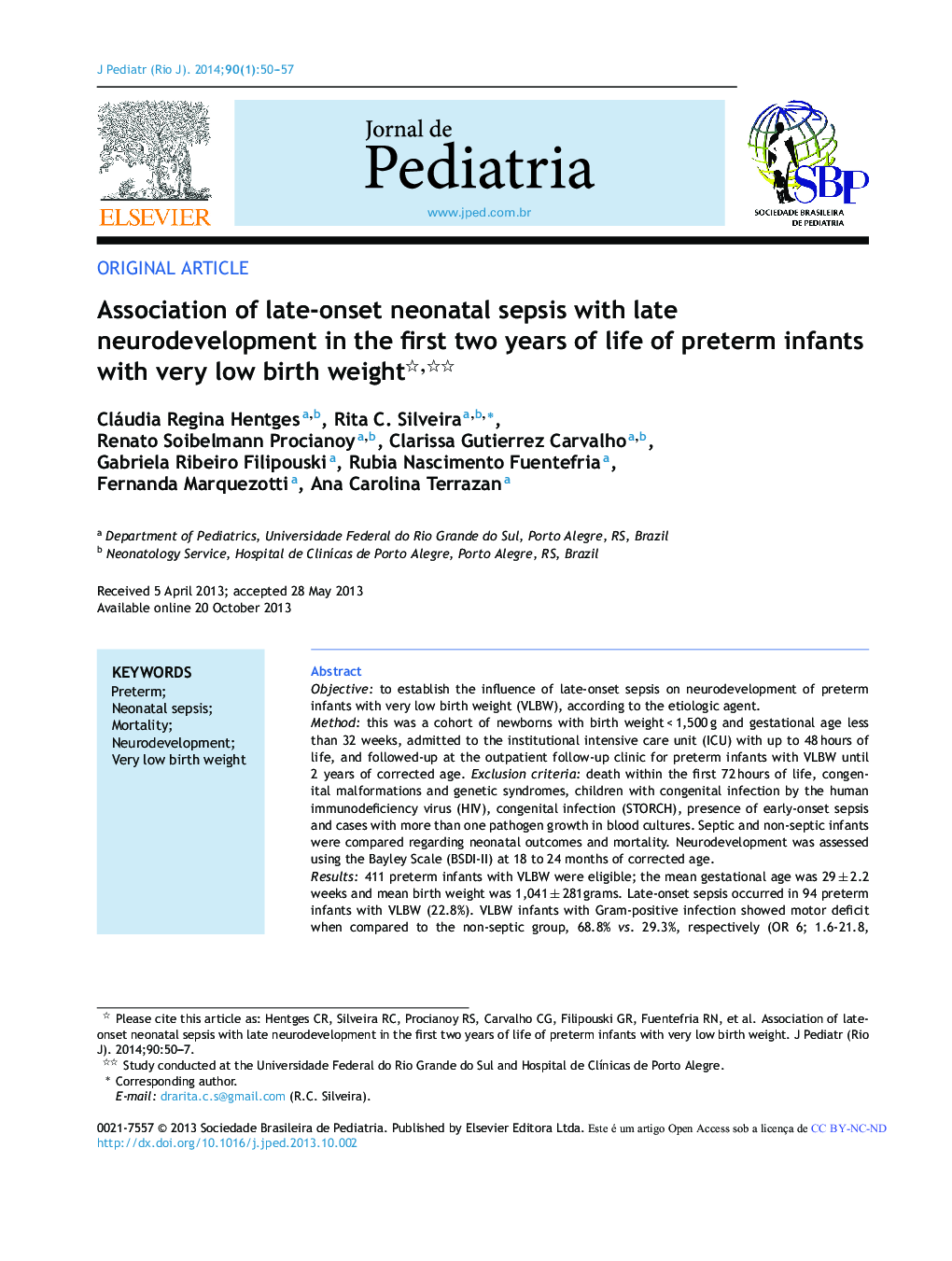| کد مقاله | کد نشریه | سال انتشار | مقاله انگلیسی | نسخه تمام متن |
|---|---|---|---|---|
| 4154120 | 1273693 | 2014 | 8 صفحه PDF | دانلود رایگان |
Objectiveto establish the influence of late-onset sepsis on neurodevelopment of preterm infants with very low birth weight (VLBW), according to the etiologic agent.Methodthis was a cohort of newborns with birth weight < 1,500 g and gestational age less than 32 weeks, admitted to the institutional intensive care unit (ICU) with up to 48 hours of life, and followed-up at the outpatient follow-up clinic for preterm infants with VLBW until 2 years of corrected age. Exclusion criteria: death within the first 72 hours of life, congenital malformations and genetic syndromes, children with congenital infection by the human immunodeficiency virus (HIV), congenital infection (STORCH), presence of early-onset sepsis and cases with more than one pathogen growth in blood cultures. Septic and non-septic infants were compared regarding neonatal outcomes and mortality. Neurodevelopment was assessed using the Bayley Scale (BSDI-II) at 18 to 24 months of corrected age.Results411 preterm infants with VLBW were eligible; the mean gestational age was 29 ± 2.2 weeks and mean birth weight was 1,041 ± 281grams. Late-onset sepsis occurred in 94 preterm infants with VLBW (22.8%). VLBW infants with Gram-positive infection showed motor deficit when compared to the non-septic group, 68.8% vs. 29.3%, respectively (OR 6; 1.6-21.8, p = 0.006); the cognitive development was similar between the groups. The overall mortality rate from infection was 26.7%; considering the pathogens, the rates were 18.7% for coagulase-negative Staphylococcus, 21.8% for Gram-positive bacteria, and 50% for Gram-negative bacteria and fungi.Conclusionneonatal sepsis has a significant influence on late neurodevelopment at 2 years of corrected age in preterm infants with VLBW, and Gram-positive infections are associated with motor deficit.
ResumoObjetivoestabelecer a influência da sepse tardia no neurodesenvolvimento de prematuros de muito baixo peso (MBP) recém-nascidos (RNs) de acordo com o agente etiológico.MétodosCoorte de RN com peso de nascimento < 1.500 ge idade gestacional < 32 semanas, internados na UTI da instituição dentro de 48 horas de vida, e atendidos no ambulatório de MBP para até dois anos de idade corrigida. Foram excluídos: a morte nas primeiras 72 h de vida, malformações congênitas e síndromes genéticas, filhos de mães HIV-positivas e infecção congênita, presença de sepse precoce, e os casos com mais de um microorganismo identificado em hemoculturas. RNs sépticos e não sépticos foram comparados quanto resultados neonatais, mortalidade e neurodesenvolvimento avaliadas através das escalas Bayley (BSDI-II) aos 18-24 meses de idade corrigida.Resultadosum total de 411 RNs prematuros de muito baixo peso eram elegíveis, com idade gestacional = 29 ± 2,2 semanas e peso de nascimento = 1.041 ± 281 g. Sepse tardia ocorreu em 94 casos (22,8%). MBP RN com infecção causada por microrganismos Gram-positivos apresentaram atraso motor, quando comparado com o grupo sem sépsis - 68,8% vs 29,3% (OR 6; 1,6-21,8, p = 0,006), e atraso cognitivo, foi semelhante. Taxa de mortalidade global de infecção foi de 26,7%, e as taxas de mortalidade por grupo microorganismo foram: Staphylococcus coagulase negativa, 18,7%; Gram-positivos, 21,8%; Gram-negativas e fungos, 50%.Conclusãoa sepse neonatal tem uma influência significativa no atraso no desenvolvimento neuropsicomotor aos dois anos de idade corrigida em prematuros de muito baixo peso RN e infecções Gram-positivas estão associadas com atraso motor.
Journal: Jornal de Pediatria - Volume 90, Issue 1, January–February 2014, Pages 50–57
